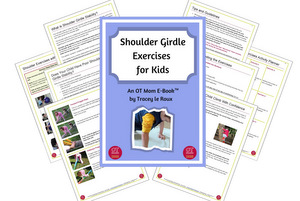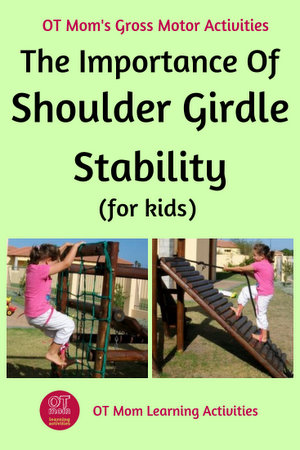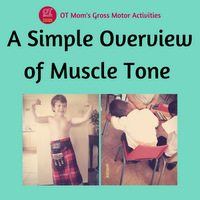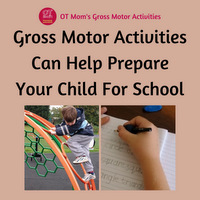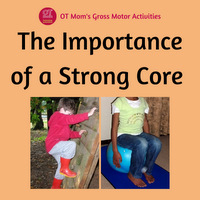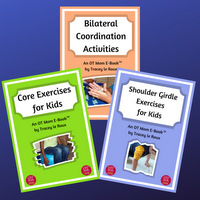- Home Page
- Gross Motor Skills Explained
- Shoulder Girdle Stability
Shoulder Girdle Stability
Did you know that good shoulder girdle stability can help support your child's fine motor development?
There are many upper body exercises and activities for kids that work on improving the strength and stability of the shoulder girdle muscles, some of which are on my site.
I sometimes link to products (#Ad) that are similar to those I use and love. If you do purchase something through my links, I will receive a small commission that helps support my site - thank you!
But this article will hopefully help you understand why shoulder girdle stability is so important!
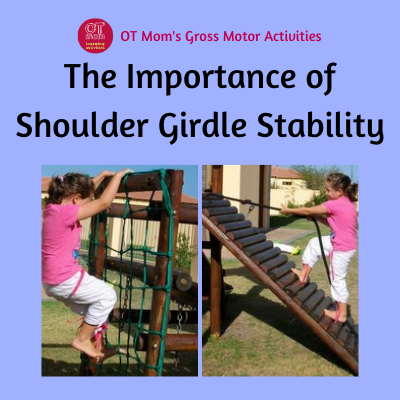
Shoulder Girdle, Fine Motor Skills & Handwriting
Your clavicles (collar bones) and
scapulae (shoulder blades), together with the ligaments and muscles which connect to them, form a circle around the top of your rib cage. This is your shoulder girdle.
The shoulder girdle forms a stable base from which your shoulder joint can move, and
enables you to throw overhand and to carry out swimming strokes like the
crawl/freestyle, as well as supporting arm movements from the shoulder joint.
Shoulder girdle stability is thus the stability that takes place when the large muscles of the shoulder girdle (among others, the pectoral muscles in front and the trapezius and rhomboidus muscles at the back) contract together effectively to stabilize the shoulder blade and the shoulder joint.
This stability “sandwich” enables the smaller muscles in the arms and hands to work more efficiently because they have been given a stable base of support.
This can affect handwriting as well as other fine motor tasks.
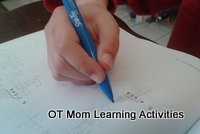 Shoulder girdle stability can affect handwriting
Shoulder girdle stability can affect handwritingTherapists often talk about needing proximal stability for distal mobility. This means that the large joints close to the body need to be stable, in order to provide a stable base for accurate movement at the joints further away from the body, such as the hand and fingers.
Good upper body strength and shoulder girdle stability (proximal stability, close to the body) will help your child to cut with scissors and to write without getting tired or producing messy work (distal mobility at the hands and fingers).
Other fine motor tasks such as craft work, tying shoelaces etc are also much easier to carry out when the shoulder girdle muscles give good stability so the hands and fingers can work effectively.
Core stability forms a further stable platform for movements of the shoulder and scapula, so we often combine activities that work on core strength as well as shoulder girdle stability.
Development of Upper Body Strength In Kids
Your child's upper body strength, including shoulder stability, should develop through exposure to a large range of gross motor activities.
In infants, lying on the tummy and pushing up on the arms, as well as creeping/crawling will help the muscles of the shoulder girdle to develop.
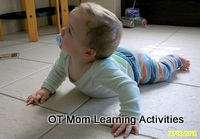 Pushing up on the arms
Pushing up on the armsChildren should be encouraged to take part in activities that involve climbing, pushing, pulling, throwing and weight-bearing through their arms, in order to strengthen all the muscles around the shoulder joints and the scapulae.
In other words, ditch the screens and get your children active!
My Shoulder Girdle Exercises for Kids E-Book contains LOTS of fun ideas for upper body exercises that kids can do at home or at the park. All the activities are easy to do at home or at school, use minimal equipment, and best of all, come with photographed instructions!
Does My Child Have Poor Shoulder Girdle Stability?
Weakness or damage to a muscle, low muscle tone, or lax ligaments can all affect shoulder girdle stability to a greater or lesser degree.
But many kids have poor shoulder girdle stability from a lack of exposure to gross motor activities - perhaps a sedentary lifestyle, a deprived environment, or too much time spent on devices instead of gross motor play.
So, how can you know if your child has poor shoulder girdle stability?
Observe your child during a pencil-and-paper task and ask yourself these questions:
- Can you see the shoulder move as your child colors, draws or writes?
- Does your child use whole arm movements when coloring or drawing (instead of hand and finger movements)?
- Does your child tire easily during fine motor tasks?
- Does your child tense up the neck and shoulders when attempting to cut with
scissors, draw/write or use a knife and fork?
The children below are displaying tension at their shoulders and movement at their shoulders while they are doing a fine motor task.
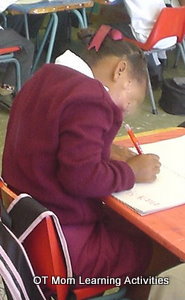 elevated shoulder while writing
elevated shoulder while writing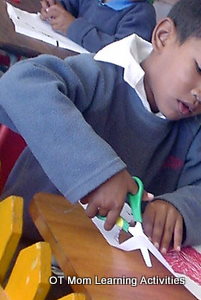 elevated shoulder while cutting
elevated shoulder while cutting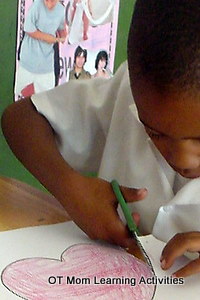 elevated shoulder while cutting
elevated shoulder while cuttingAlthough young children attempting a task for the first time may hold their arms awkwardly or in an exaggerated way, they should soon relax as they become more accomplished.
But if your kindergarten or grade school child approaches every fine motor task with tension in the shoulders and tiring easily, then you may have reason to be concerned.
An assessment by a pediatric physical therapist or occupational therapist can help to identify and treat the underlying cause of the poor shoulder girdle stability, which may be low muscle tone, developmental delay, or a genetic disorder, or simply lack of exposure.
How Can I Help My Child Develop Upper Body Strength?
Probably the first, and hardest step, is to simply help your child get more active! See how you can incorporate more gross motor games and sports in your child's life.
- Try and get a park date in once a week, and see if you can go swimming, which is great for all-over body strengthening.
- Look for activities and games that involve pushing, pulling, clambering and crawling. Obstacle courses are great for these!
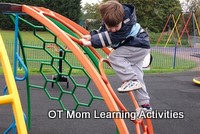 climbing
climbing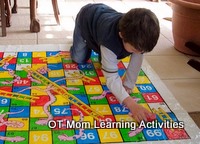 playing on all fours
playing on all fours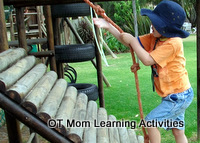 pulling on a rope
pulling on a ropeSometimes kids need encouragement to work specifically on upper body and core strength, particularly if they have struggled with these activities in the past.
Here are some pages on my website with free activities that specifically target those areas:
Shoulder Girdle Exercises - Printable Download
Does your child need to work on upper body strength and stability?
Does your child have poor fine motor skills because of poor shoulder girdle stability?
This printable resource will provide you with LOADS of photographed exercises for the price of a couple of coffees!
View my Shoulder Exercises for Kids E-Book now!
These activities are offered to promote your child's normal development. They are NOT a substitute for occupational therapy assessment and treatment.
Thanks for visiting!
Please do sign up for my free, occasional newsletter to stay in touch with new or updated pages on my site!
- Home Page
- Gross Motor Skills Explained
- Shoulder Girdle Stability
Share this page to help others!
Related Pages
References
K Au, M.; M Chan, W.; Lee, L.; MK Chen, T.; MW Chau, R.; and Pang, M. Core Stability Exercise Is As Effective As Task-Oriented Motor Training In Improving Motor Proficiency In Children With Developmental Coordination Disorder: A Randomized Controlled Pilot Study. Clinical Rehabilitation. 28(10) March 2014. https://doi.org/10.1177/0269215514527596 (abstract only)
Mcgill, Stuart. (1999). Stability: From biomechanical concept to chiropractic practice. J Can Chiropr Assoc. 43.
Oliver, G.; Stone, A.; Weimar, W.; Lemak, L.; Washington, J.; and Dougherty, C. Upper Extremity Muscle Activation during Bodyblade Exercises Following Six Weeks of Intervention Focusing on the Lumbopelvic-Hip Complex. Sports 2015, 3(3), 188-201; 3. 188-201. https://doi.org/10.3390/sports3030188
Oliver, G.; Stone, A.; Plummer, H. (2010). Electromyographic Examination of Selected Muscle Activation During Isometric Core Exercises. Clin J Sport Med. 2010 Nov; 20(6):452-7. doi: 10.1097/JSM.0b013e3181f7b0ef. https://www.ncbi.nlm.nih.gov/pubmed/21079441
Voight, Michael & Paine, Russ. (2013). The Role of the Scapula. International Journal of Sports Physical Therapy. 8. 617- 629. https://www.ncbi.nlm.nih.gov/pmc/articles/PMC3811730/
Didn't find what you were looking for? Try a search of my site!
